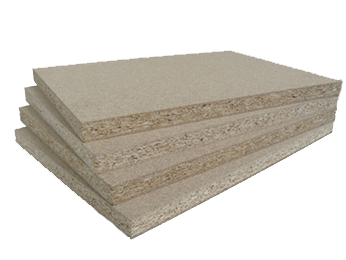Wood chipboard (DSP) - the most popular material for the production of furniture, also used during construction and finishing works. Wood chipboard is used as partitions, roofing and flooring, for interior design, in the manufacture of furniture.
The main advantage of chipboard is its mechanical strength and availability for mechanical processing. This material is easy to cut, drill, it can be milled, planed, painted and glued. In addition, the cost of chipboard is relatively small. Chipboard is made by pressing wood chips and shavings at high temperature. The raw material for the manufacture of chipboard is almost any wood of both softwood and hardwood. The presence of water-repellent, antiseptic and other additives ensures the strength and durability of the material.
 The first stage of chipboard production is the processing of raw materials. Round wood is used as raw material. In the second stage, the resulting chips are sorted, cleaned and dried. Then from the resin and chips form the so-called "carpet", from which, after pressing, the plate is obtained. Next, the edges of the slab are machined and the slabs are subjected to various forms of machining - grinding, coating (laminating). In the finished slab, unlike natural wood, there are no knots, cracks, internal voids. A weighty advantage is good strength, rigidity, uniformity, ease of processing.
The first stage of chipboard production is the processing of raw materials. Round wood is used as raw material. In the second stage, the resulting chips are sorted, cleaned and dried. Then from the resin and chips form the so-called "carpet", from which, after pressing, the plate is obtained. Next, the edges of the slab are machined and the slabs are subjected to various forms of machining - grinding, coating (laminating). In the finished slab, unlike natural wood, there are no knots, cracks, internal voids. A weighty advantage is good strength, rigidity, uniformity, ease of processing.
Depending on the quality of chipboard surface treatment, its grade is determined. First-class slab should be ground, on the surface should not be scratches, chips, and other mechanical defects, the edges should be smooth. Furniture is made of first-class polished chipboard. First grade must be checked for the amount of formaldehyde contained. Only chipboard with a safe amount of this substance can be considered environmentally friendly. The level of formaldehyde emission is determined by the “chamber” method. The essence of this method consists in measuring the level of a harmful substance in the air of the chamber into which the sample of polished chipboard was placed. This method is the most common and is considered the most effective. Modern manufacturing methods allow to produce polished chipboard with formaldehyde content significantly lower than the established maximum permissible concentration. In this regard, chipboard can be considered safe for health.
Grinding defects (no more than 10% of the area) may be on the surface of the second grade plate;
For the production of furniture, slabs of polished chipboard are laminated. Laminated chipboard comes in a wide variety of colors and shades. The most common and frequently used in the manufacture of furniture are wood decors.
Chipboard lamination - lining of chipboard with films based on papers impregnated with melamine resins. At high temperature and pressure, the resin melts and is extruded from the film. In this process, the film adheres to the surface of a particle board, and the resin, polymerizing, gives the surface properties of a thermosetting plastic, which is highly resistant to mechanical damage and to chemicals. The surface turns out dense, steady against a wet environment, differences of temperatures. Lamination can be both glossy and matte with a rough surface.
Furniture made of laminated chipboard is the best alternative to furniture made of wood. After all, chipboard is a quality material that meets international safety standards and is used now as the main material for furniture production.
For the manufacture of furniture after cladding, laminated chipboard slabs are cut into parts of the required dimensions, and their edges are “chrome-plated”. The edges of the parts covered with a special edge, for example, melamine or PVC.
Emission class displays free formaldehyde content in 100 grams of a completely dry slab. Content up to 10 mg of formaldehyde is designated as "E1". From 10 to 30 mg - "E2".
Quality, environmental friendliness, beautiful appearance, durability, a large selection of colors and affordable prices - that is why laminated chipboard has become the main material in the manufacture of furniture.

